The AMD Radeon RX Vega 64 & RX Vega 56 Review: Vega Burning Bright
by Ryan Smith & Nate Oh on August 14, 2017 9:00 AM ESTPower, Temperature, & Noise
Moving on from performance metrics, we’ll touch upon power, temperature, and noise. This is also normally where we’d discuss voltages, but as Vega is a new chip on a new architecture, nothing seems to read Vega 64 and 56 correctly.
In terms of average game clockspeeds, neither card maintains its boost specification at 100% with prolonged usage. Vega 64 tends to stay closer to its boost clocks, which is in line with its additional power overhead and higher temperature target over Vega 56.
| Radeon RX Vega Average Clockspeeds | ||
| Radeon RX Vega 64 Air | Radeon RX Vega 56 | |
| Boost Clocks |
1546MHz
|
1471MHz
|
| Max Boost (DPM7) |
1630MHz
|
1590MHz
|
| Battlefield 1 |
1512MHz
|
1337MHz
|
| Ashes: Escalation |
1542MHz
|
1354MHz
|
| DOOM |
1479MHz
|
1334MHz
|
| Ghost Recon: Wildlands |
1547MHz
|
1388MHz
|
| Dawn of War III |
1526MHz
|
1335MHz
|
| Deus Ex: Mankind Divided |
1498MHz
|
1348MHz
|
| GTA V |
1557MHz
|
1404MHz
|
| F1 2016 |
1526MHz
|
1394MHz
|
| FurMark |
1230MHz
HBM2: 868MHz |
1099MHz
HBM2: 773MHz |
With games, the HBM2 clocks ramp up and stay at their highest clock state. Expectedly, the strains of FurMark cause the cards to oscillate memory clocks: between 945MHz and 800MHZ for Vega 64, and between 800MHz and 700MHz for Vega 56. On that note, HBM2 comes with an idle power state (167MHz), an improvement on Fiji's HBM1 single power state. Unfortunately, the direct power savings are a little obscured since, as we will soon see, Vega 10 is a particularly power hungry chip.
As mentioned earlier, we used the default out-of-the-box configuration for power: Balanced, with the corresponding 220W GPU power limit. And under load, Vega needs power badly.
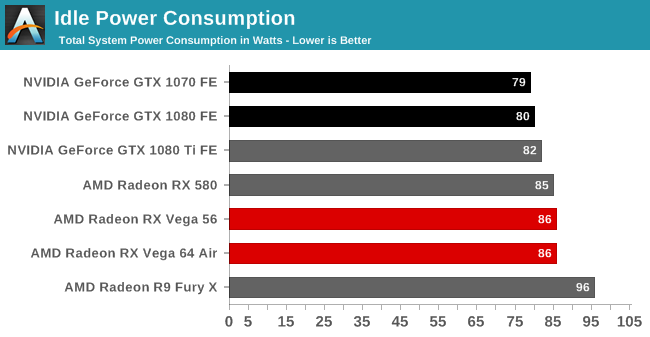
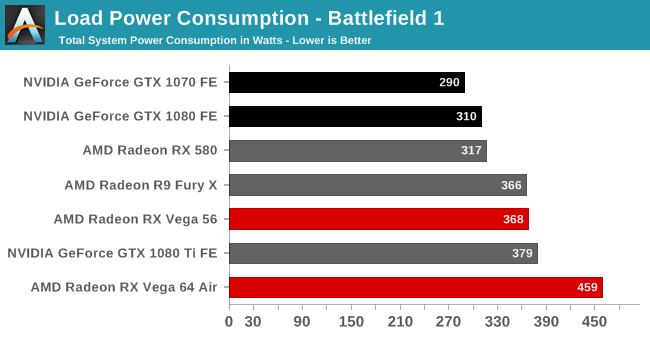
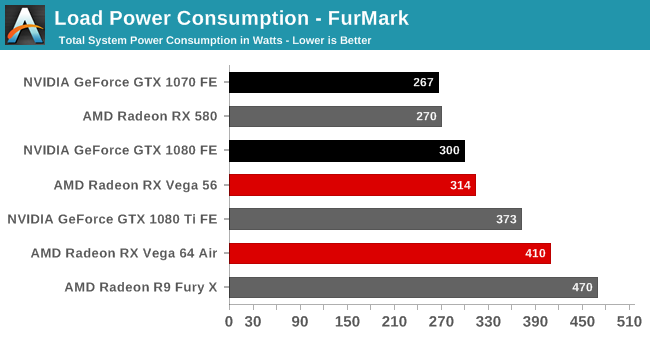
The performance of both Vega cards comes at a significant power cost. For the RX 500 series, we mused that load consumption is where AMD paid the piper. Here, the piper has taken AMD to the cleaners. In Battlefield 1, Vega 64 consumes 150W more system-wide power than the GTX 1080, its direct competitor. To be clear, additional power draw is expected, since Vega 64 is larger in both shader count (4096 vs. 2560) and die size (486mm2 vs. 314mm2) to the GTX 1080. But in that sense, when compared with the 1080 Ti, powered by the 471mm2 GP102, Vega 64 still consumes more power.
As for Vega 64's cut-down sibling, Vega 56's lower temperature target, lower clocks, and lower board power make its consumption look much more reasonable, although it is still well above the 1070.
In any case, the cooling solutions are able to do the job without severe effects on temperature and noise. As far as blowers go, RX Vega 64 and 56 are comparable to the 1080 Ti FE blower.
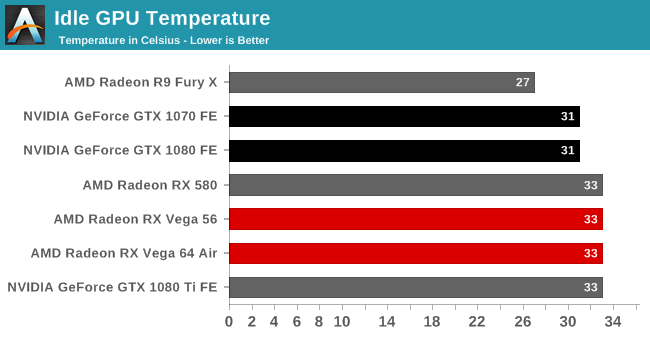
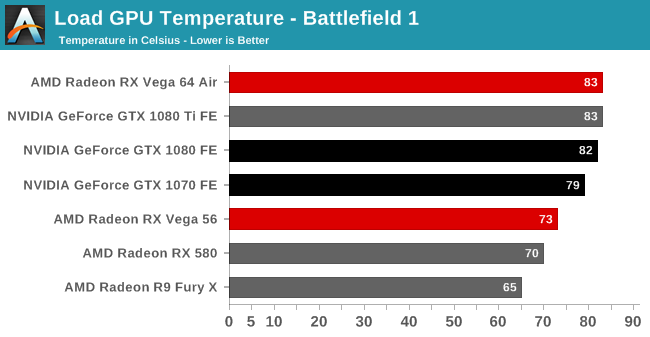

Not Graphed: Temperature of the actual Vega (Star): 9329C
Noise-testing equipment and methodology differ from past results, with a more sensitive noise meter and closer distance to the graphics card. Readings were also taken with an open case. As such, the noise levels may appear higher than expected.

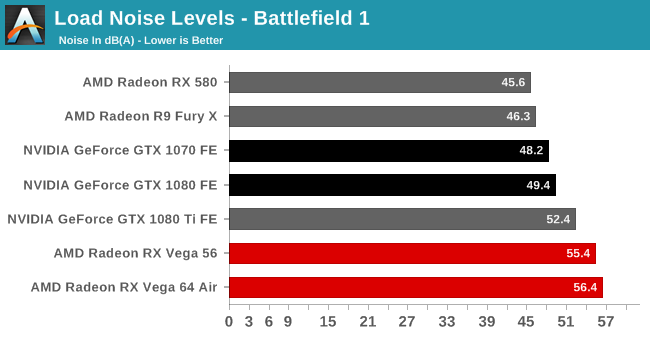
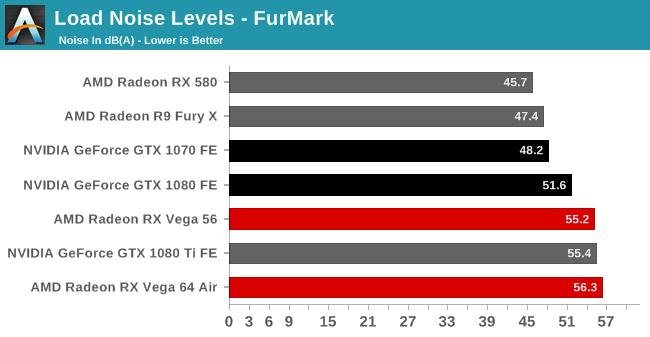










213 Comments
View All Comments
MatthiasP - Monday, August 14, 2017 - link
Only poor people buy the air cooled Vega and not the liquid one.FreckledTrout - Monday, August 14, 2017 - link
LOL I care about power consumption because it makes my computer loud. Did you see how loud t he Vega 64 is, way way to many db's for me. So some not "poor" people care.Aldaris - Monday, August 14, 2017 - link
Freckled, did you not pay attention to that graph? It's basically as loud as Nvidia's offerings.sorten - Monday, August 14, 2017 - link
If by "basically as loud" you mean that the AMD cards are 10% louder, then yes. Power draw translates to heat and, typically, noise. I would never buy the AMD cards given the power draw, but to each their own.Brett Howse - Monday, August 14, 2017 - link
dB is a logarithmic scale. 3dB means twice as much sound, although we don't perceive it as that much. Closer to 10 dB would be perceived as twice as loud. Vega 64 vs 1080 FE is about 7 dB difference, which isn't "basically as loud" it's going to be perceived as a lot louder.Lazacom - Tuesday, August 15, 2017 - link
Nope, logarithmic sound scale means 3dB is around 23% larger amplitude of sound waves. 10dB is perfect 2 times more. But our ears usually don't register 1-3dB difference. On the other hand, 7dB should be heard as difference, but again depends what frequencies are most loud, around 1kHz are most noticeable. If they wrote it basically as loud, probably there are lower frequencies spikes contrary to 1080Ti...bcronce - Tuesday, August 15, 2017 - link
Decibel is base 10. 10dB is 10x more energy. 3dB is about 47% more energy.Dug - Tuesday, August 15, 2017 - link
Anyone that deals with audio, knows that 3db is noticeable. 1db is perceivable, but not usually noticed if it's constant. The issue with sound from a case is that it can actually be like a speaker, so just because the card is 3db more at 1m in free air, it can become quite a bit louder due to cabinet size and materials. Just like putting a case under a desk can sometimes be louder than if on top of the desk. Last is heat. If case fans have to operate at higher levels to keep heat from video card down, then this will add to perceived loudness.Exodite - Monday, August 14, 2017 - link
While the power consumption of the cards, Vega 64 in particular, is disappointing I'd await 3rd party cooling systems before judging.The stock AMD cooling solution has been terrible since, well, forever really. And while I prefer AMD GPUs I've learned to avoid stock cards like the plague.
mapesdhs - Monday, August 14, 2017 - link
Exodite, 3rd party coolers can help with the noise, but I can't see them doing much about the power behaviour.